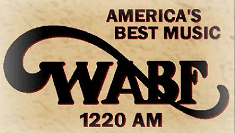WABF
 | |
| City of license | Fairhope, Alabama |
|---|---|
| Broadcast area | Mobile, Alabama |
| Slogan | "America's Best Music" |
| Frequency | 1220 kHz |
| First air date | August 12, 1961 |
| Format | Adult Standards/MOR |
| Language(s) | English |
| Power |
1,000 watts (day) 30 watts (night) |
| Class | D |
| Facility ID | 32848 |
| Transmitter coordinates | 30°30′39″N 87°54′13″W / 30.51083°N 87.90361°W |
| Affiliations | CBS Radio Network |
| Owner | Gulf Coast Broadcasting Company, Inc. |
| Sister stations | WDXZ, WBZR-FM, WCSN-FM |
| Website | wabf1220.net |
WABF (1220 AM) is an American radio station licensed to serve the community of Fairhope, Alabama, since 1961. The station's broadcast license is currently held by Gulf Coast Broadcasting Company, Inc.
WABF broadcasts an adult standards/middle of the road music format to the greater Mobile metropolitan area, including Mobile County and Baldwin County, Alabama. In addition to its usual music programming, the station broadcasts a tradio show called The Gulf Coast Swap Shop, local news, and select programming from the CBS Radio Network.[1]
History
This station began regular operations as "WABF" on August 12, 1961. Licensed to Eastern Shore Broadcasters, Inc., the station was originally part of the J. Dige Bishop Stations Group.[2] It broadcast with 1,000 watts of power, daytime-only, to protect WGAR (now WHKW) in Cleveland, Ohio, from skywave interference.[3]
Almost two decades later, Eastern Shore Broadcasters, Inc., sold WABF to Bee Cee Broadcasting, Inc., in a deal that closed on July 1, 1978.[4] In March 1992, Bee Cee Broadcasting, Inc., reached a deal to sell WABF to Jubilee Broadcasting Company, Inc., for $350,000. The deal was approved by the FCC on April 20, 1992, and consummated on May 11, 1992.[5] In February 1999, Jubilee Broadcasting Company, Inc., contracted to transfer the broadcast license for WABF to Gulf Coast Broadcasting Company, Inc. The deal gained FCC approval on May 5, 1999, and the transaction was formally consummated on May 20, 1999.[6]
In June 2001, the station applied to increase its nighttime signal strength from 4 to 30 watts while eliminating the directional array in use both day and night to reduce skywave interference. The FCC granted a construction permit for these changes on October 1, 2001, with a scheduled expiration date of October 1, 2004.[7] With construction and testing complete in January 2002, the station applied for a new broadcast license to cover these changes. The FCC granted the new license on March 11, 2002.[8]
References
- ↑ "Station Information Profile". Arbitron. Retrieved December 31, 2011.
- ↑ "Directory of AM and FM Radio Stations in the U.S.". 1963 Broadcasting Yearbook. Washington, DC: Broadcasting Publications, Inc. 1963. p. B-5.
- ↑ "AM Station Classes: Clear, Regional, and Local Channels". Federal Communications Commission, Audio Division. Retrieved December 31, 2011.
- ↑ "Directory of Radio Stations in the United States and Canada". Broadcasting/Cable Yearbook 1982. Washington, DC: Broadcasting Publications, Inc. 1982. p. C-4.
- ↑ "Application Search Details (BAL-19920309EB)". FCC Media Bureau. April 20, 1992. Retrieved December 31, 2011.
- ↑ "Application Search Details (BAL-19990219ED)". FCC Media Bureau. May 20, 1999. Retrieved December 31, 2011.
- ↑ "Application Search Details (BP-20010621AAG)". FCC Media Bureau. October 1, 2001. Retrieved December 31, 2011.
- ↑ "Application Search Details (BL-20020114ABF)". FCC Media Bureau. March 11, 2002. Retrieved December 31, 2011.
External links
- Official website
- Query the FCC's AM station database for WABF
- Radio-Locator Information on WABF
- Query Nielsen Audio's AM station database for WABF
| ||||||||||||||||||||||